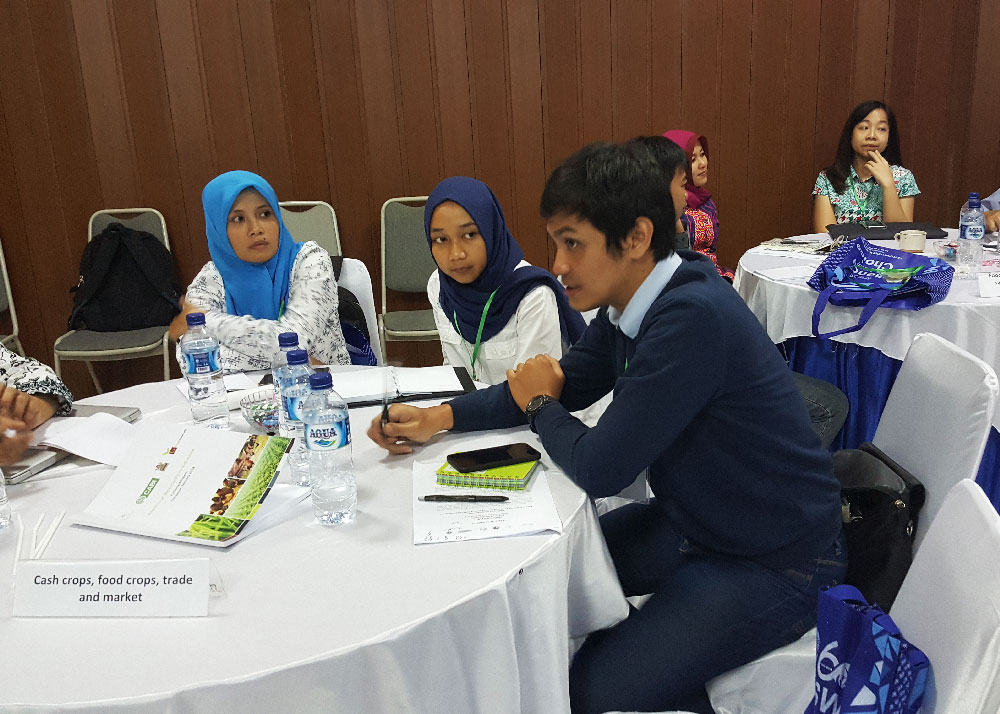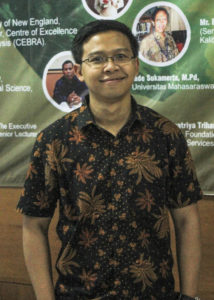

Understanding the Potential of Local Plants in Supporting Food Security: A Study Case in Salatiga
February 20, 2019
The Crawford Fund Regional Master Class in Plant Biosecurity conducted in Salatiga, Central Java, Indonesia from 10-16 February 2019 was hosted by Universitas Kristen Satya Wacana (UKSW) Salatiga, and supported by the Indonesian Biosecurity Foundation (IBF), with assistance from Plant Biosecurity Science Foundation and CABI.
As part of the selection process, participants wishing to join the master class were requested to write an essay on the theme of the program. This week we are highlighting three of these outstanding essays. In this blog we are featuring Andreas Binar Aji Sukmana, from the Universitas Kristen Satya Wacana (UKSW) in Salatiga, Central Java and their submission titled “Understanding the Potential of Local Plants in Supporting Food Security: A Study Case in Salatiga.” Also read essays by Agnes Cela Purwani and Rohning Sulistyani.

By Andreas Sukmana

Salatiga is a small city located near Merbabu mountain, it is blessed with fertile soil and plenty of water supply. Fertile soil combined with water promotes a success in the agriculture sectors. There was no major incident reported related to a food security issue in Salatiga in years. Salatiga even contributed in support food security by having a successful rice harvest earlier this year. However, around the same time, the price of rice in Salatiga was significantly increase by 20%. Introducing a potential threat to the local food security. The increase on the price was triggered by the crop failure in West Java, which is quite far from Salatiga. The effect of price increase can theoretically be alleviated if the other sector on food security is solid. Therefore, further steps need to be taken because Salatiga is not immune to the food security threat
One key component of having a solid food security is diversity. The diversity can come either in the form of genetic or species level. The importance of plant genetic diversity is now being recognized as a critical factor contributing to food security in a world with a constantly growing population. Genetic diversity is the base for survival of plants in nature and for crop improvement. Following the basic theory of evolution, diversity is the raw material for evolution. More diversity correlate with a better chance of survival during a natural selection. In contrast, a less diverse condition is more susceptible to a disturbance. If a trait is sensitive to a particular stress and got eliminated, then the resistant trait will still survive and can be used to cover the loss of the sensitive trait. Therefore, the diversity can act as the safety net, ensuring a solid food security.
Genetic diversity in crop plants in Salatiga is demonstrated, for example, by the presence of different varieties of rice plants. Interestingly, some of the varieties are actually the improved versions of the local varieties such as Pandan Wangi and Umbul. Those varieties are evidence of the importance of local varieties. Local plant varieties provide valuable germplasms which are important for the overall gene diversity in the gene pool. The germplasm from a local plant can be used to create new variety which has enhanced traits and more suitable for a particular environment.
The phenomenon in Salatiga in early 2018 demonstrated that genetic diversity alone is not enough to ensure a solid food security. The price of rice was increasing because the demand for rice is still strong while the supply was decreasing. Even if Salatiga can fully supply its own rice, the price would still be increased because of the interconnected rice demand-supply chain in Indonesia. One idea that can potentially alleviate this problem is by introducing an alternative for rice. Carbohydrate sources other than rice can be consumed to minimize the demand for rice and at the same time keeping food security in check. The diversity in the species level gives greater options for people to choose from. The source of species diversity mainly comes from the variety of local plants. The local plants usually have been adapted to the local environmental conditions. Not only that diversifying food source with local plants beneficial for strengthening food security, but it also offers an added value from the nutritional perspective.
Some local plants that can be an excellent rice replacement as the carbohydrate source are cassava, sweet potato, ganyong, kimpul, gembili, dan gadung. They are all producing tubers
to stores food supplies in the form of starch. Cassava (Manihot esculenta) and sweet potato (Ipomoea batatas) are more common than the other mentioned plants. They can be easily found in Salatiga and they can be processed into a wide variety of food. Ganyong (Canna spp.), kimpul (Xanthosoma sagittifolium), gembili (Dioscorea esculenta), and gadung (Dioscorea hispida) on the other hand are relatively harder to be found today in Salatiga. They were quite common decades ago and their disappearance is predicted due to the lack of recognition from the community. Moreover, they are considered as not versatile as both cassava and sweet potato. If they get the same recognition and treatment to those of the cassava and sweet potato, it is possible that they can be a solid rice replacement.

The lack of community recognition on the local plants can actually be overcome with the collaboration of academia, industry, and government. Academia can explore the benefits of the local plants and disseminate their finding to the public to raise an awareness toward the local plants. Industry can bring innovations closer to the public to further introduce the benefit of local plants. The government can issue regulations to ensure the continuity of this program and further support it with deeper integration to the community. Unfortunately, a fully integrated continuum among academia, industry, and the government is still rarely seen in Salatiga due to its complexity.
The whole integration is not a simple and short process. The problem of local plants disappearing is urgent and alternatively the immediate action that can be done is preserving the germplasm for future uses. The preservation can be initiated by universities as the higher education’s arrow spear by collecting local plants and their germplasm. Some plants with aesthetic values can even be planted on campus, making the campus as a mini library showcasing potential local plants. Therefore, this mini library will be a great tool to reintroduce the local diversity and to bring the concept of diversity as well as food security closer to the community. This plan seems doable in Salatiga because there is Satya Wacana Christian University (SWCU) which has departments/faculties that are ready to support the program; such as the Faculty of Biology, the Faculty of Agriculture, as well as the Faculty of Sciences and Mathematics. The green area inside the campus can be used to display many local plants, not only from Salatiga but also from all across Indonesia, matching SWCU motto “mini Indonesia”.
Selected references
Anonim. (2018, January 8). Panen di Kota Salatiga Ikut Memperkuat Stok Pangan. Swadaya. Retrieved from http://www.swadayaonline.com/artikel/654/Panen-di-Kota-Salatiga-Ikut-Memperkuat-Stok-Pangan/.
Bhanu, A.N. (2017). Assessment of Genetic Diversity in Crop Plants – An Overview. Adv. Plants Agric. Res. 7.
Govindaraj, M., Vetriventhan, M., and Srinivasan, M. (2015). Importance of genetic diversity assessment in crop plants and its recent advances: an overview of its analytical perspectives. Genet. Res. Int. 2015, 431487.
Henderson, I.R., and Salt, D.E. (2017). Natural genetic variation and hybridization in plants. J. Exp. Bot. 68, 5415– 5417.
Rosa, A. (2018, May 30). Stok Beras di Salatiga Cukup hingga Tiga Bulan ke Depan. Sindonews.com. Retrieved from
https://daerah.sindonews.com/read/1310235/22/stok-beras-di-salatiga-cukup-hingga-tiga-bulan-ke-depan- 1527677070.
Wiyono, P. (2018, January 11). Harga Beras di Salatiga Naik, Ini Penyebabnya. Tribunnews. Retrieved from http://jateng.tribunnews.com/2018/01/11/harga-beras-di-salatiga-naik-ini-penyebabnya.
The Crawford Fund has a number of programs to encourage the next generation in international agriculture for development and the training of international researchers. We are proud to sponsor researchers in biosecurity in Indonesia with thanks to our partners. For further reading on the importance of biosecurity in Indonesia, here are the links to the other two essay submissions: “Local food, food safety and food sovereignty local food,” by Rohning Sulistyani from the Agriculture Department, Kota Salatiga, Indonesia and “The Importance of Plant Biosecurity,” by Agnes Cela Purwani, Semaran, Indonesia.




